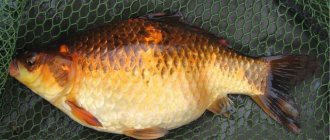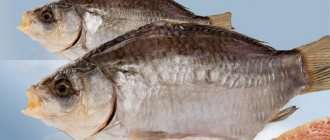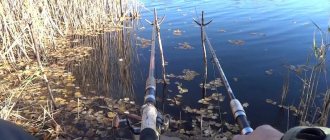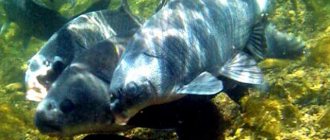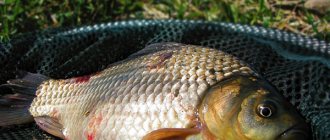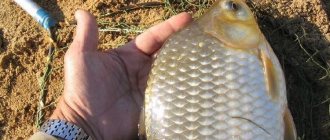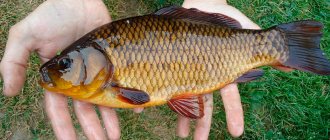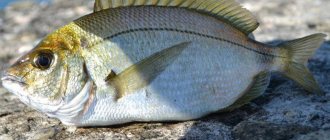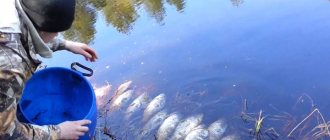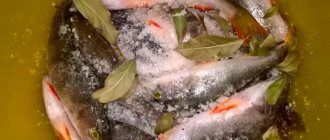Description
crucian carp
belongs to the genus
crucian carp
, belonging to the fish of the carp family. It has a tall body, laterally compressed. The back is thick and the dorsal fin is long. The scales of the fish are large and smooth to the touch. The color can be different: from silver to golden.
In the wild, crucian carp is represented by two species - silver (oblong)
and
golden (ordinary round)
crucian carp.
Silver crucian carp – Carassius gibelio – is the most common species. Golden (golden) crucian carp – Carassius carassius. There is also a third species: Goldfish
is an artificially bred aquarium species.
Goldfish
has external differences from golden fish. They consist not only in the color of the scales, which have a silver, gray, greenish-gray or slightly golden, orange-pinkish tint. Body proportions may vary. It depends on the location and living conditions of the fish. But unlike the common crucian carp, the silver one, when viewed from the side, has a pointed muzzle. A distinctive feature is that the dorsal and anal fins are not similar to the others. Their first ray looks like a jagged and hard spike. The remaining rays of the fins are soft. The caudal fin has clear outlines. Only this type of crucian carp is capable of reproducing by gynogenesis.
Golden or common crucian carp
prefer the same habitats as silver ones. However, they are much less common. The fish differ primarily in the color of their scales. In common crucian carp it has a golden shimmer. The shape of the head when viewed from the side is round. Individuals of this species are smaller in size. Their characteristic feature is the coloring of the ventral, caudal and dorsal fins in a dark brown color. Therefore, silver crucian carp with golden scales continue to be called silver. It’s just that its fins do not differ in color from its scales.
Description of crucian carp
Crucian carp are members of the carp family, a genus of ray-finned fish.
Appearance
This fish has a long dorsal fin, a high body with a thick back, which is moderately compressed from the sides. The scales of crucian carp are large and smooth to the touch, and the color of the body can vary depending on the habitat.
Depending on the variety, the length and weight of crucian carp vary. Thus, golden crucian carp can reach a body length of more than 50 centimeters and a weight of over 3 kilograms, and silver crucian carp can reach a length of up to forty centimeters and a weight of up to two kilograms.
Varieties
Fish of this genus are usually divided into five species, the most famous of which are the following:
Common or golden crucian carp
This representative of crucian carp is distributed in fresh water bodies from Central Europe to the Lena basin.
Goldfish
Initially, this species lived in the Pacific Ocean, as well as in Siberian rivers, and then was artificially settled in reservoirs from Europe to Siberia.
Interestingly, in some rivers and lakes the population of silver crucian carp is represented exclusively by females. Spawning in such females occurs with males of related fish species, for example:
- roach,
- golden crucian carp,
- tench,
- bream,
- carp
gold fish
This form of crucian carp was artificially bred in China from its fellow crucian carp, and is very similar to it.
Similarities and differences between gold and silver crucian carp
Purely outwardly, gold and silver crucian carp are very similar and live together in some rivers and lakes. However, as a rule, during coexistence, the golden crucian carp is gradually replaced by its silver counterpart. A hybrid of silver and gold crucian carp is also sometimes found.
The differences between these fish are as follows:
- The scales of goldfish have a yellow tint: from reddish and copper to bronze or golden. In turn, silver crucian carp most often has a gray-silver and gray-greenish color. Although sometimes there are silver carp and yellow ones.
- Goldfish have more than thirty scales in the lateral line. But the scales of silver crucian carp are larger.
- From the side, the golden head looks rounded, while the silver one, as a rule, has a pointed head.
- Young golden crucian carp are distinguished by the presence of a dark spot on the body in front of the caudal fin. This spot usually disappears with age. But its silver counterpart does not have this spot at all.
Distribution and habitats

Initially, crucian carp lived in the Amur River basin and the reservoirs that were adjacent to it. In the second half of the last century, they were distributed artificially in European and Siberian reservoirs. Currently, fish are spreading to India, North America and other regions. At the same time, the number of common crucian carp is rapidly decreasing, as they are being replaced by silver crucian carp.
Crucian carp lives in reservoirs with a soft bottom and stagnant water, which warms up well under the sun. The fish prefers to settle in areas well overgrown with aquatic vegetation. It can be caught in quiet creeks, river channels, ponds and flooded quarries. Crucian carp are undemanding about the oxygen content in water, so they get along well in wetlands, which freeze to the bottom in winter. You can rarely find them in flowing ponds and lakes, but they stay near the bottom of the reservoir.
Crucian carp (silver, golden)
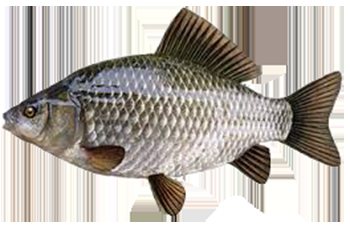
Silver crucian carp differs from gold crucian carp in having larger and lighter scales and a shorter body height. As a rule, the color of the scales is silver-gray or greenish-gray, but occasionally there are specimens with a golden or even pinkish-orange color. The ratio of body height to length can vary significantly depending on living conditions.
The first ray of the dorsal and anal fins is a hard, jagged spine, the remaining rays are soft.
Silver crucian carp reaches 40 cm in length and weighs up to 2 kg. Some specimens live up to 10–12 years. Initially, silver crucian carp lived in the Amur River basin and adjacent reservoirs. Artificially resettled in the 60s of the 20th century in many reservoirs of Siberia and Europe. Now introduced to North America, India and other regions. At the same time, in European and Siberian reservoirs there was a gradual displacement of common crucian carp (golden carp) by silver crucian carp, up to the complete disappearance of the latter.
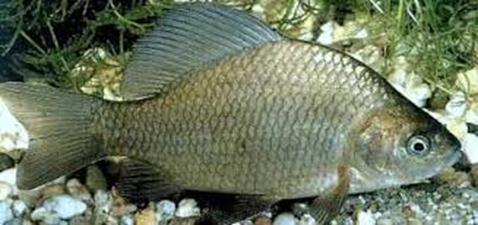
Spawning is portioned and can occur from one to three times a year, depending on the water temperature. As a rule, there are 4–6 times fewer males than females. In some reservoirs, the population of silver crucian carp is represented only by females. In such reservoirs, female goldfish spawn with males of related fish species (roach, goldfish, tench, bream, carp and others). True fertilization does not occur, since the sperm does not fertilize, but only stimulates the development of eggs. In this case, only females appear in the offspring. This method of reproduction is called gynogenesis.
Silver crucian carp is an object of fish farming, like carp, as well as an object of fishing, sports and recreational fishing.
Based on the subspecies of silver crucian carp, aquarium goldfish and other ornamental breeds were bred in China in the 11th century.
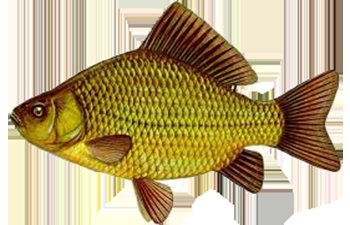
Golden crucian carp. The body of the golden crucian carp is short, tall, covered with golden scales. The color of the back is dark green, the sides and belly are golden. Unlike the common crucian carp, it has a long dorsal fin, large scales, many gill rakers and vertebrae, and a small number of rays in the anal fin. The mouth is terminal, without antennae. The peritoneum is black. Lives up to 14-15 years, usually 7-10 years. Reaches a maximum length of 45 cm and a weight of more than 1 kg, usually no higher than 20 cm and 350 g. It usually grows somewhat faster than common crucian carp, reaching 45 cm in length and a weight of 1 kg. High-bodied and low-bodied forms are noted depending on the food supply of the reservoir. It feeds on plankton, detritus, algae, insect larvae, worms and other invertebrates.
It becomes sexually mature at the age of 2-4 years. Fertility is from 30 to 400 thousand eggs. Spawning is portioned, usually in May. The population of this species often consists of females alone, which participate in spawning with males of other cyprinid species. The sperm penetrates the egg without fertilizing it, but only stimulates development. The offspring are only female (gynogenesis).
A species with a huge modern range spanning Eurasia and America. The natural habitat of golden crucian carp is China, Japan, the islands of Taiwan and Hainan. Thanks to artificial breeding, it has spread throughout the world. In Russia, golden crucian carp and its breeds first appeared in the 17th century. and were kept in the royal ponds. It was also bred in fish farms in the Kursk and Belgorod regions and in the Krasnodar region.
The range of goldfish currently extends from Spain and France to the Far East, covering much of Europe and Asia. In the east, it is found in the lakes of the Amur basin, rivers of Sakhalin, and in the basins of Indigirka, Alazeya, and Kolyma. Introduced from the Amur basin to Kamchatka. Found in the reservoirs of the Lena, Ingoda, Selenga, Yenisei, Ob, and Irtysh basins. In Western Siberia, the northern border of the range extends beyond the Arctic Circle, and the southern border reaches the Black Irtysh basin and lakes on the northern slopes of Altai. In the north of the European part of Russia it is found in the Mezen, Pechora, and Northern Dvina basins. To the west of the Urals there are in the basins of the Urals, Volga, Dnieper, Southern Bug, Dniester, and Danube. According to one point of view, the spread of golden crucian carp in Europe is the result of a very long-standing importation from China or Japan, according to another, in Central Europe it is autochthonous.
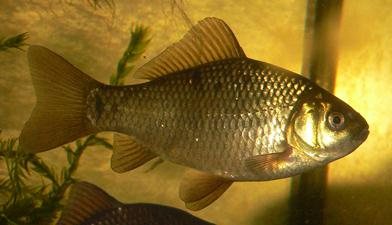
Golden crucian carp and its varieties are an object of applied ornamental fish farming. There are more than a hundred breeds of goldfish. These are comet, wakin, shubunkin, veiltail, diakines, ranchu, lionheads, orandas, telescopes and others. The length of the body, the length and shape of the fins change, there are fish with outgrowths on the head and with enlarged eyes. There are several color variations: red, silver, black and others. The most varied combinations of these characteristics and coloring give an extraordinary variety of goldfish shapes. She is believed to have more breeds than any other domestic animal. Goldfish live long, up to 35-40 years. In nature, golden crucian carp at times gives a sharp outbreak in numbers. So over the past 20 years, its numbers have sharply increased in the deltas of our southern rivers.
Interesting articles about fishing:
- Fishing for crucian carp. Secrets
- What do crucian carp bite on and where to look for it?
Age and size
Depending on the color and size of large individuals, they are divided into species. At the same time, common crucian carp is found weighing more than 3 kilograms, and its body length is more than half a meter, silver carp weighs up to 2 kilograms and is 40 centimeters in length. Individuals of this size are already old; young, but mature fish weigh about 700-800 grams.
In small pools, especially close to housing, crucian carp rarely reach more than 0.8-1.2 kg. weight, but under favorable conditions, especially in the north, they have incomparably larger sizes, and then they grow exclusively in thickness or height.
Crucian carp becomes capable of reproduction in the third year and in very rare cases reaches a weight of 400g. before four or five years. Most of the three-year-old caviar crucian carp, as is known, are usually significantly less than 200g. The normal size of a two-year-old crucian carp is 4 cm. , but with especially abundant food, for example, if you throw food to crucian carp, crucian carp reach 300g in two years. weight.
Undoubtedly, the growth of crucian carp, like any other fish, depends mainly on the amount of food, and since it feeds exclusively on plant matter, it is understandable why in pools with a sandy bottom, devoid of aquatic grasses, it grows very slowly.
If there is an excessive number of crucian carp, their growth also decreases, but sometimes a slowdown in growth occurs for completely different reasons.
Gold
Golden crucian carp is popularly called common. It is introduced into reservoirs from Eastern Europe to the mouths of the Lena River. A photo of this class is presented below.
The golden representative of cyprinids is quite unpretentious, so it can be found in rivers, lakes and ponds. It moves through different types of waters due to normal migration patterns, and this form can also be cultivated artificially.
Golden crucian carp can have different sizes. Its growth depends on the intensity and quality of nutrition. In places where there is not enough food, its body size by the age of two can reach only 5-6 centimeters. Under favorable external conditions, the fish can become very large at this age, its weight can reach 300 grams, and its size can be 25 cm. In artificial lakes where crucian carp are raised by people, their size can be even larger.

Golden crucian carp has a body type that is flattened on the sides, but it is quite tall. Because of this type of body, this crucian carp was nicknamed round. The body height of this fish is usually only half its length. The golden type has large scales that fit tightly to the body of the fish. An adult crucian carp usually has 30 to 40 scales in a row. His head is quite small, his mouth is of the appropriate size, in which there are several small teeth.
Note! The back of a healthy representative of this class is light in color. While its back is more brown, sometimes even greenish.
The fish's fins are arranged in pairs and may have a reddish tint.
This subspecies can perfectly adapt to environmental changes. Of all the representatives of cyprinids, this subspecies is the most tenacious. As stated earlier, it can adapt to any type of water.
If crucian carp lives in reservoirs where there is not enough food, then its offspring adapt to such conditions. The fish's head becomes larger while its body size decreases. Growth dynamics slow down significantly. Puberty in this case occurs much earlier.
Goldfish are found well in muddy and marshy areas. It is almost impossible to encounter this species in clear waters. For the winter, he buries himself in the silt and stops any activity, he doesn’t even eat. Even if the reservoir in which crucian carp lives is completely frozen, this species does not die. By spring, it completely restores its life cycle. This species can live in cold waters for a long time; it simply stops producing offspring. This is one of the few representatives of the aquatic world that has similar abilities; other cyprinids simply die at low water temperatures.
Usually golden crucian carp reaches adult age at two years; if living conditions are difficult, this process can take up to 5 years. Spawning of this species takes place in May-June; the water temperature should not fall below 13 degrees. Females can lay from 10 to 100 thousand eggs per spawning. Their diameter is usually from 1 millimeter. The spawning period lasts 3 days. The breeding season for this type of cyprinid lasts until August, during which time the female can lay eggs up to 4 times.
Crucian carp of this species under normal conditions does not migrate between habitats. But due to the fact that its caviar is quite sticky, it often settles on the feathers of fish. Due to this, this species often appears in bodies of water where it has not been previously seen.
Lifestyle
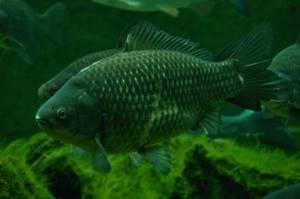
The difference between ordinary crucian carp and silver carp is insignificant, so it makes no sense to consider each species separately. Crucian carp is perhaps the most unpretentious fish, as it can live in any type of reservoir, both with standing and running water. At the same time, fish can be found in semi-underground reservoirs covered with quagmire, as well as in small reservoirs where, except for crucian carp and rotan, no fish can survive.
The more mud there is in a reservoir, the better for crucian carp, since in such conditions crucian carp can easily obtain food for themselves in the form of organic residues, small worms and other particles. With the onset of winter, the fish burrow into this silt and survive even in the harshest snowless winters, when the water freezes to the very bottom. There is evidence that crucian carp were dug out of the silt from a depth of 0.7 meters absolutely alive. Moreover, this happened in the complete absence of water in the reservoir. Golden crucian carp are particularly resilient, so it is almost impossible to find a body of water wherever this fish is found. Crucian carp often end up in small ponds or lakes absolutely by accident, especially after the spring flood. At the same time, it is known that fish eggs are carried by wild waterfowl over considerable distances. This natural factor allows crucian carp to inhabit reservoirs far from civilization. If the conditions for the development of crucian carp are quite comfortable, then after 5 years the reservoir will be full of crucian carp, although before that it (the reservoir) was considered fishless.
Crucian carp is found in many bodies of water, although to a lesser extent it is found in rivers and some lakes, which is due to the nature of the reservoir itself. At the same time, it may choose creeks, bays or creeks, where there is a lot of algae and a muddy bottom, although the reservoir itself may have a sandy or rocky bottom. Crucian carp itself is quite clumsy and has a hard time coping with even the slowest current. Many predators take advantage of the slowness of this fish and can soon exterminate the entire population of crucian carp if it has nowhere to hide. At the same time, juvenile fish and eggs suffer greatly. In addition, if the bottom is hard, then the crucian carp will remain hungry and are unlikely to take root in such conditions.
Crucian carp is not afraid of cold water, as it is found in the Urals, as well as in pits at considerable depth with spring water.
Appearance and features

Photo: Crucian fish
Having understood the individual characteristics of each variety of crucian carp, it is worth giving a general description of the appearance of this very common fish. Externally, crucian carp is very similar to carp, this is not surprising, because they are members of the same family. When comparing them, the most important distinguishing feature is the smaller head. The mouth of the crucian carp is also smaller than that of the carp and does not protrude forward as much; it does not have a mustache.
The body shape of the crucian carp is oblong, but high, somewhat reminiscent of a diamond; the body of the fish is flattened on the sides. The large dorsal fin has a smooth outline. The fish is covered with smooth and large scales, the colors of which vary between species, but the most common colors are golden and silver. The fish ridge is quite powerful and thickened.
The small mouth opening contains single row pharyngeal teeth. Basically, the eyes of crucian carp are small. One of its differences is the presence of prickly barbs on the anal and dorsal fins. The standard weight of crucian carp is from 200 to 500 grams; larger and heavier specimens are rarely found.
The life span of different types of crucian carp is different. The Golden Krasya can be considered a long-livers; it can live more than 12 years. Goldfish rarely survive nine years of age, although some manage to overcome this milestone and live for a couple more years, but this happens extremely rarely.
The difference between crucian carp and carp
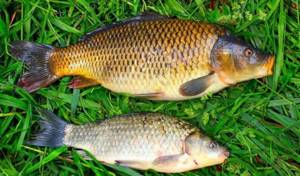
There is no doubt that an experienced fisherman will be able to distinguish these fish without any problems. But some difficulties may arise for beginner fishermen. Let's try to understand the similarities and differences.
Both types of fish belong to the same family and have similarities, for example:
- Colors,
- Massive body;
- Large scales;
- Fin color and size.
All these similarities can be identified, rather at a superficial glance. If you look more closely, the differences become more obvious.
The main differences between these fish include the following:
- The dorsal fin of the carp is noticeably longer, but less in height.
- The body of the carp is somewhat elongated, while the crucian carp, especially the golden one, is more round in shape.
- The presence of mustaches in carp
- The weight of an adult carp is several times greater
Additional differences:
Carp Crucian carp
Hump on the nose Straight contours of the head Fleshy lips Thin lips The body is full, elongated, flexible The body is tall, compressed Dark, large scales The scales are lighter, smaller, harder Notch on the fin Smooth fin Larger and heavier Smaller, lighter
We recommend reading: Winter pike fishing with girders
What does crucian carp eat?
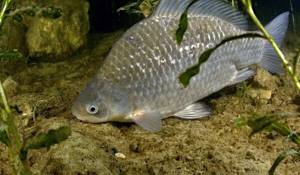
Photo: River fish crucian carp
Crucian carp can be called an omnivorous aquatic inhabitant. Its menu is quite varied. Let's trace the taste preferences of fish, starting from the moment of birth. The fry that are born have a yolk sac with them, which remains with them after embryonic development; they use the contents of this sac for nutrition, which maintains their strength and energy.
Slightly mature crucian carp begin to feed on daphnia and blue-green algae. Closer to the month, bloodworms and larvae of various insects living in the water appear in the babies’ diet.
Mature fish have a richer and more varied menu. Their diet includes annelids and small crustaceans, all kinds of insect larvae. The roots and stems of plants in the coastal zone also serve as food for crucian carp. He loves to eat duckweed and various algae.
Fishermen have long understood that crucian carp are not averse to eating all sorts of cereals:
- buckwheat;
- wheat;
- pearl barley
The buttery dough and crumb of bread for fish are real delicacies. Crucian carp's sense of smell is simply excellent, so it senses a particular type of bait from afar. It has been noticed that crucian carp like harsh and strong odors (for example, garlic), which fishermen use for their baits.
The lateral line of crucian carp can be called an organ of its finest sensitivity, with the help of which the fish scans the water column, receiving data about the location of prey, its dimensions, and the distance to it. It also determines the presence of predatory ill-wishers.
From the fact that crucian carp did not like hornwort, it contains a lot of tannin, which repels insects and larvae, which crucian carp like to eat.
Kinds
Based on shape, size, color of scales, and habitat, crucian carp fish are divided into many species.
GOLDFISH
The gray tint of the silver color is sometimes replaced by grey-green scales of the fish depending on the habitat. The 45 cm long species lives in fresh water for about 7-9 years. The weight of an adult crucian carp is up to 3.5 kg. Fresh river fish.

Externally, his body and head form a kind of sharp edge. The scales are very large. The dorsal fin is not convex at the end, but concave inward. This species previously lived even in the Pacific Ocean. Through Siberian water streams it entered European water bodies. Research has shown that the migration of crucian carp was accomplished artificially.
Females spawn together with males of other fish. Together with carp, bream, roach. This means that their fertilization occurs in the absence of male sperm. Then the crucian carp develops by laying eggs. At this spawning, only females produce fry.
GOLDEN CROSS
Fish with an elongated body. Covered with large scales of a golden hue. A brown or copper tint is visible. Individuals are larger than silver fish. They reach a length of 0.5 m. They are also ahead of the silver ones in terms of mass. On average they gain 5-6 kilos. Life activity is 13 years.
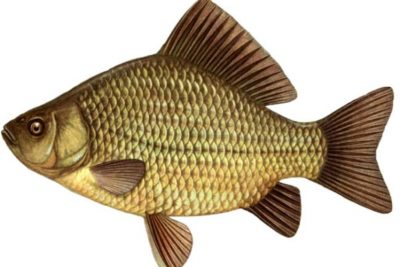
Body structure with a convex dorsal fin. The head of the golden one is unlike its other brothers. It's rounded. The belly is without the usual pigments. It lives mainly in swampy waters of lakes and coastal reed thickets.
Interestingly, golden crucian carp spend the winter individually. In a sleepy state, it buries itself in the bottom silt of the lake. In this position, all the cold sleeps. This allows the type to survive the cold even when the surface of the water is bound by an ice shell.
Scientists note that the depth of burrowing into the silt reaches 75 cm. The fish loves underwater vegetation. If the bottom of the lake is sandy and there is no silt provided by nature, the growth of the species is very slow.
NAUTICAL
It bears the second name “Laskir”. Habitat: Azov and Black Seas. Rarely found in warmer seas. The fish differs significantly from its freshwater “brothers” in appearance. The “weasel” has a different way of life.
Caution and fear are in the first place for sea crucian throughout life. It is very easy for a novice fisherman to scare him off. The marine type has an oblong body. The sides are flat. The color is yellow, the belly shines with silver lighter than the body. A dark-colored spot near the tail feathers of the fish is the main sign of golden crucian carp.

Teeth in rows. First, the wide incisors. Afterwards - chewing.
The size of the individual is small. The most outstanding in length are up to 35 cm. The weight of crucian carp is less than that of river or lake “relatives”. Rarely exceed 1 kilo.
However, the seas are richer filled with living organisms than those of freshwater types. This means that sea crucian carp naturally receives some traits that allow it to live calmly in the salty world. The differences repel many predators when attacked. They are given sharp “rays” of the anal fin. Fish uses them as weapons in conflicts with other water inhabitants. For this reason, fishermen nicknamed the sea crucian “ruffy fish.”
Likes to be located at a small coastal distance. Inhabit rocks and hide in them. During calm periods, schools of weasel go into the sea, to the depths, but rarely move; the fish are mostly sedentary.
There are decorative subtypes of sea crucians (for aquariums). There are subclasses in the sea - “goldfish”, white Japanese, crucian carp mabuna. They are either not intended for fishing, or are very rare in habitat.
How does crucian carp reproduce?
Puberty in crucian carp occurs only in the fourth or fifth year of life. At the same time, males mature earlier. Spawning of these fish begins in water well heated to 15-18 degrees in May or early June. Crucian carp spawn in several stages, in portions, pausing for a week and a half.

Females spawn close to the shore on aquatic plants. Very sticky yellow caviar attaches well to leaves and stems. One female is capable of laying up to 300 thousand eggs. The number of males participating in spawning is always four or five times less than females. Their group spawning takes place quite noisily, with splashing water, for two or three days.
The incubation period lasts about a week, then the larvae appear, located inside the yolk sac, from which they receive nutrients. The hatched fry first feed on plankton. Growing up, juvenile crucian carp gradually switches to plant foods and bottom animal organisms.
Crucian carp has a rare ability for fish to adapt well to the conditions of a particular body of water. When it is swampy and the diet is mainly plant-based, crucian carp grow more slowly and are smaller. Even their appearance may change - the body becomes more elongated. With good nutrition and living conditions, crucian carp become the owners of a tall body and gain weight well.
Female silver crucian carp spawn with male carp fish - roach, carp, bream, golden crucian carp. Only females emerge from the eggs. This method of reproduction is known as gynogenesis.
Spawning
As a rule, spawning begins in late May or early June, depending on the weather. Crucian carp becomes capable of reproduction in the third year, by which time it weighs between 200-400 grams.
The breeding period occurs when the water warms up to a temperature of 17-18 degrees. Spawning itself takes place in several stages with breaks of about 10 days. The light yellow caviar (and this is up to 300 thousand eggs) is laid by crucian carp on aquatic vegetation.
The eggs and newly hatched juvenile crucian carp are eaten by frogs, newts and swimming beetles. The latter often eat already quite large specimens of crucian carp, and also pursue adult representatives of this fish.
Dangerous enemies of crucian fish
In reservoirs, the main enemies of crucian carp have always been predatory fish, especially pike. It’s not for nothing that popular wisdom appeared: that’s what the pike is for, so that the crucian carp doesn’t doze off. Of course, other predators also attack the clumsy and sleepy crucian carp. He often becomes a victim of asp and pike perch.
This fish is destroyed in large quantities by newts and frogs, which mercilessly eat crucian caviar. In addition, recently born crucian carp fry become their prey. Equally dangerous enemies of fish fry are water beetles - very aggressive swimmers, gargle beetles, and water bugs that attack fry. Moreover, the larvae of these beetles are even more aggressive and voracious.
Crucian carp are attacked from the air by birds - seagulls, kingfishers. Birds are also becoming carriers of dangerous fish diseases. In ponds and lakes, small crucian carp are easily caught by ducks, especially species such as grebes. Gray herons can eat dozens of crucian carp.
Predatory animals that swim beautifully are no less dangerous for crucian carp. Otters and muskrats constantly hunt for fish, and muskrats and ferrets are not far behind them. The crucian carp is deftly tracked and caught perfectly by the fox.
But more than others, the crucian population is destroyed by a man with a fishing rod, of course. Most often, good-natured crucian carp that come close to the shore are caught with a float rod. But other well-known gear is also used to catch them - a spinning rod, a feeder, an elastic band, a spring.
The most common bait used is worms, bloodworms, maggots, pieces of dough, bread balls, steamed grains of wheat, corn, and peas. Millet, semolina and corn porridges are also used. The bait is flavored with fragrant vegetable oils, anise drops, and fruit flavors.

Fishermen consider cottage cheese and buckwheat porridge to be excellent bait for crucian carp; sometimes a drop of aromatic laurel or anise essential oil is added to them for scent. Bait for crucian carp is usually prepared from crackers, pearl barley, oatmeal, bran, boiled millet, and cake.
The gear used for catching crucian carp is the most inconspicuous, and the fishing line is thin, because this fish has a keen eye. The most favorite fishing spot is considered to be a pond overgrown with reeds near the shore with a depth of up to three meters. Fishing enthusiasts also practice using small crucian carp as bait for predatory fish.
Crucian carp loves pungent smells; they make him feel uneasy. Fishermen often provoke it to bite by smearing the bait with fragrant vegetable oil - sunflower or linseed, garlic, and even dripping gasoline on it.
Features of catching golden crucian carp
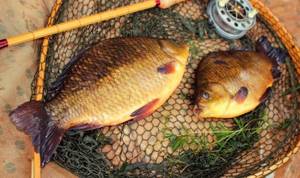
Catching goldfish is not difficult. Most often you have to catch among algae and water lily leaves. You will need a float rod, a fishing line with a thickness of 0.2-0.25 mm, a mandatory leash of 0.15 mm, a hook No. 4-5 according to the domestic classification, an elongated float with good sensitivity. The baits or lures are placed in the bottom to mid-depth range.
The best bait for catching goldfish is a small dung worm or a bunch of bloodworms. In places close to civilization, golden crucian carp can be caught on pearl barley and other plant baits. But still, taking into account the fact that the main food for fish is algae and small bottom-dwelling mollusks, preference should be given to animal bait.
Read! Catching a predator on the track
Population and species status
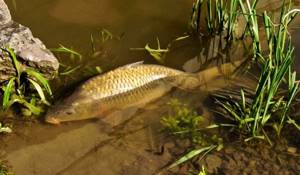
Photo: Karas
Golden crucian carp have approximately the same sex ratio. In its silver relative, the population of females is many times more dominant than the male population. There is evidence that the number of males among silver crucian carp is only about ten percent. Not so long ago, golden crucian carp was the dominant species in many reservoirs, but now the situation has changed, and in various places it has been replaced by its silvery counterpart after being artificially relocated. More and more often, hybrids formed by crossing these two species began to appear.
Despite the fact that crucian carp fishing is quite active, its population does not suffer from this; it still remains a widespread fish species. Ichthyologists have evidence that over the past 50 years there has been stability in the number of crucian carp. There are no jumps in the direction of a sharp increase or decrease in the population. And the number of silver crucian carp is increasing everywhere. The status of its species states that this fish is an object of sport, local and amateur fishing.
So, the crucian carp is not in danger of extinction, and its distribution area is very extensive. Perhaps the crucian carp owes this to its most important qualities - unpretentiousness, great endurance and excellent adaptability to various habitats.
In the end, it remains to add that although the situation with the crucian carp population is favorable, people should not resort to poaching, catching en masse this good-natured and peaceful inhabitant of quiet reservoirs. Crucian carp will not be able to resist incessant poaching. Sitting on the shore for fun with a fishing rod is one thing, but widespread placement of nets is a completely different story, which smacks of trouble and negativity.
Reproduction
Golden crucian carp is one of the species leading a sedentary life. It does not make long migrations. The duration of spawning for golden crucian carp is no more than two days.
One adult female spawns from twenty-five to thirty thousand eggs. Such high fertility is explained quite simply - the eggs and the water have the same specific gravity. Therefore, some of them attach to vegetation, while others float to the surface, becoming a delicacy for coastal birds.
Useful properties of crucian carp
Crucian carp contains up to 60% of edible parts in its body, that is, even more than carp. The fat content of crucian carp reaches 6–7%, the protein content is 18% of live weight.
Fish is practically the only product that contains in large quantities such a set of fat-soluble vitamins as vitamins A, C, D, E and B vitamins. It is rich in iodine, manganese, copper and zinc, especially sea fish.
There is a lot of iodine in the tissues of bottom fish (cod, flounder, catfish, crucian carp, etc.).
This fish, along with chicken meat, is one of the best sources of high-quality protein, which contains all the essential amino acids necessary for the body.
Young people who eat a lot of fish from childhood are more likely to succeed academically.
The dependence of intelligence on the amount of fish eaten is very significant - visual-spatial and speech abilities increase by 6%. And this is from one fish dish a week! And the increased content of fish in the diet of young people became the reason, according to Swedish researchers, for the increase in mental abilities almost twofold.
Fish in general turned out to be a very useful product for the mental development of children. Therefore, it is advisable to eat fish at least once a week.
The inclusion of fatty fish in a pregnant woman's diet has a beneficial effect on the visual acuity of the unborn child. According to scientists from the University of Bristol, who discovered this pattern, the reason for this is the substances found in fish oil. They accelerate the maturation of the baby's brain.
The components that turned out to be so important for the child are fatty acids necessary for the growth of nerve cells. They are found not only in fish, but also in breast milk. However, they are not included in even the best artificial mixtures. This is why scientists suggest adding fish oil to formula feeding formulas.
Interesting facts about crucian carp
- Kras is a fish addict. He is very attracted to the smells of inedible and sometimes very harmful products, such as kerosene, Corvalol and drops of valerian.
- The Germans call crucian carp “peasant carp.”
- The goldfish, beloved by many aquarists, is one of the subspecies of crucian carp.
- The largest crucian carp was caught on the Turukhan River, the left tributary of the Yenisei, its weight is 4 kilograms 250 grams.
- The crucian carp's brain detects various movements and senses food thanks to a special line (similar to a seam) located on the sides of the body.
These are the silver and gold crucian carp. It would seem that these are the simplest fish, but there are so many interesting things you can learn about them.
AnimalsComment
How to clean crucian carp
Freshwater or sea crucian carp is a food rich in microelements and fatty acids. Vitamins, proteins. Cooking fish dishes is quite rich in options. But first, any fish must be cleaned of entrails and scales. Proper cleaning of crucian carp scales is a small waste of time and effort. Divided into two stages:
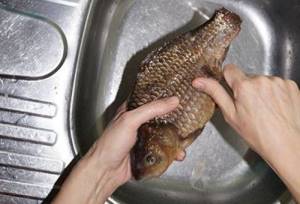
Preparation: clean the fish fresh or frozen. Fresh is still alive. She is silenced by a blow to the head with the handle of a knife. Defrosting is carried out at room temperature, but not completely. Wrap in parchment, bag, sprinkle with salt. Afterwards, the fish is rinsed with a water jet and all mucus is removed.
If the individual has a strong mud smell, you need to dip it in a salt solution for 30 minutes. Then rinse with boiling water. A 1/4 vinegar solution is effective against swamp smells.
To efficiently remove entrails and scaly cover, you need cutting tools:
- fish cleaner - a special installation, with or without a container for scales;
- a fillet knife - a boning cutter will also work well;
- chef's scissors;
- tweezers with wide jaws for bones.
With them the process will be simple and effective.
The second stage of cleaning crucian carp:
- The dorsal fin is cut out with chef's scissors. During the process I use a napkin;
- after cutting, the fin is removed starting from the tail to the head;
- the scales are removed - after cutting the dorsal fin freely;
- the insides are cleaned until the carcass is completely empty;
- Now the crucian carp is washed in cool water, several approaches;
- All blood residues are removed from parts of the carcass;
- the carcass is cut into portions for filleting;
- Use a colander to remove any remaining liquid from the portions.
Removing scales from a fish is an algorithm of short but important actions. The crucian carp is placed on the board. Sprinkle with salt. The tail is taken with the left hand using a cloth or napkin. With the right wrist, the cleaner fish is directed towards the carcass. The scales are cleaned into the container of the device or onto the board if there is no container. Removing scales in a clear direction - tail - head. To prevent your hands from slipping, dip them in salt.
HOW TO COOK CRUCCIAN - RECIPES
Everyone loves to eat delicious food. Both fisherman and hunter. And fish is also extremely useful, especially for children’s bodies.
Crucian carp has absorbed as many recipes for its preparation from its habitat. It will be difficult to describe them all. It is worth canceling the most successful ones:
CROSS IN SOUR CREAM
The main thing is to use a tasty sauce. Sour cream as a sauce is very good. For frying and stewing fish. It neutralizes the swampy smell of the carcass. Gives a delicate taste. The recipe for frying fish in sour cream begins with the ingredients:

Carcasses of crucian carp – at least 2 kg;- Vegetable oil - volume depending on the size of the frying pan;
- Vegetables, tomatoes will go – 0.4 kg;
- Onions – 0.4 kg;
- Carrots – 0.4 kg;
- Sour cream – 0.5 l;
- Wheat flour or other – 0.1 kg;
- Lemon juice – 50 ml;
- Greens for flavor, often dill, parsley - amount to taste;
- Spices, also to taste.
The carcass is rubbed with salt and spices, very tightly, the aroma and taste will increase from this. River carp is a bony fish. Before frying, the back of the fish is cut with oblique lines. This reduces the danger, inconvenience of frequent bones while eating. Smaller ones take 25 minutes to cook, large ones take up to 45 minutes.
The crucian carp, cleared of scales, mucus, entrails, and blood residues, is rubbed with lemon juice, salt and spices to taste. After soaking from rubbing for 25 minutes. Time to cut vegetables. Tomato - in rings, greens, some are chopped, some are left. The onion is peeled and cut into small cubes. The carrots are peeled, washed, and grated on a coarse grater.
Frying pan over medium to low heat. There is vegetable oil in it. The bottom heats up along with the onions and carrots. Vegetables are fried until golden brown.
The frying is removed into a separate bowl. The frying pan is heating up - a new portion of sunflower oil. The carcasses are breaded in flour. Place on a heated frying pan.
Fry without a lid until golden brown on both sides over high heat. Next, each carcass is stuffed with pieces of tomato and branches of greenery. The fish is sprinkled with chopped herbs on top to make the dish beautiful.
Sour cream is poured into the saucepan. On low heat. Gradually, fish stuffed with vegetable filling is added. For about five minutes with the lid closed, the fish is simmered in sour cream until it boils. The saucepan is removed from the heat. Cool for 15 minutes with the lid closed until the fish is completely soaked.
Crucian carp in sour cream served cold or hot. With or without a side dish is not so important.
CROSS IN THE OVEN
The carcass is baked in the oven. On a baking sheet, in foil or sleeve. Add vegetables (to taste) - they will be a side dish that will save time on making it later.
To cook crucian carp in the oven with mayonnaise, the following ingredients are required:

Crucian fish – 4 pcs.;- Mayonnaise – 0.2 kg;
- Onions - 3 pcs.;
- Vegetable oil – 2 tbsp. spoon;
- Salt, pepper - to taste.
Prepared in several steps:
- The prepared fish is salted and peppered. The baking sheet is covered with foil. It is lubricated with a thin layer of oil;
- Onions are placed in rings on the oil “sheet”. There are fish carcasses on it. They are already covered with a “blanket” of the remaining onion rings. Everything is lubricated with mayonnaise;
- The oven heats up to 200 degrees. Bake for at least 25 minutes.
The dish is served hot when ready. If you come across fish with caviar, you can make another dish - caviar. The fish are baked, the caviar is separated from the crucian carp. Place separately in a bowl, season with salt:
- The caviar masses are salted. Serve separately as an appetizer, garnished with herbs and a slice of lemon;
- Fry separately with vegetables. (at least 0.4 milk);
- Cutlets are being prepared. (consists of: fish caviar, eggs, semolina).
Caviar dishes have an exquisite taste. Bon appetit!
Crucian carp fish gives the experienced fisherman and novice fisherman a thrill from the process of fishing in any waters. At lunch, it satisfies true gourmets with a variety of dishes.
Gives quality fishing to a private breeder. Afterwards a delicious meal is on his table. Industrial fishermen benefit from a continuous stream of profits due to the ease of reproduction and the hardiness of the species.
Commercial value
Crucian carp have always been valuable commercial fish. The silver crucian carp, which has increased its numbers and has taken root well in many reservoirs, has also become a popular object of commercial fishing, especially in Kamchatka.
Growing crucian carp in pond farms is widespread; farmers are increasingly breeding this fish by equipping crucian ponds.
Every year, several thousand tons of crucian carp are caught in the rivers and lakes of Russia. This does not include those that grow in artificial ponds on farms.
Taste qualities of crucian fish
The meat of crucian carp is white and very tasty. It is considered a dietary product because it contains protein, which is easily digestible, as well as many useful vitamins - A, D, E, saturated fatty acids and mineral elements. Crucian carp meat is rich in calcium and phosphorus; it contains magnesium, chromium, iron, fluorine, molybdenum, sodium and nickel.
A delicious aspic is prepared from crucian carp. But the most luxurious dish, especially for fish gourmets, is crucian carp cooked in sour cream. Fish can be fried and baked. Ukha cooked over a fire from freshly caught crucian carp is a real delicacy.

